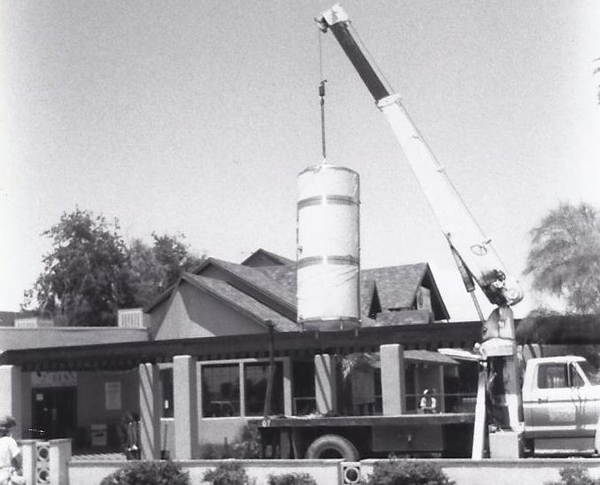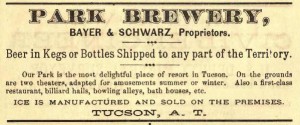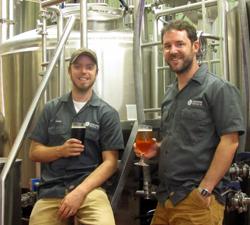Brewing History in a Sour Environment

The original Gentle Ben’s in 1991 while under construction.
photo courtesy Dennis & Tauna Arnold
The abundance of beer brands and styles available for us to choose from today is staggering, and the success of the craft beer industry is nothing less than a remarkable story of American ingenuity.
According to the Brewers Association, as of March 2013, there were 2,416 breweries in the United States, of which 2,360 are small, independent craft breweries. Arizona is home to 44 craft breweries, with more preparing to open.
If one could only travel back in time to Arizona’s territorial days, it would be interesting to bring back Alexander Levin – the first brewer to embark on brewing beer commercially in Arizona – to get his reaction to the state of today’s beer industry.
Levin was a Prussian-born and trained brewer who, at 30 years of age in 1864, established the Pioneer Brewery in the dust-laden settlement of Tucson.
Unlike today’s brewers, who have all the provisions and resources for starting a brewery available virtually at their fingertips, Levin built his brewery with limited means in a nearly impossible environment for supporting a brewery at a time when the science of brewing beer was not fully understood. Water and raw materials were scarce, artificial refrigeration had not yet been devised, hops – not a native crop in Arizona – was imported from other regions and pure yeast cultures were virtually unattainable. The crushing, malting and roasting of the grain was accomplished manually by sight and feel over long hours of back-breaking work.
This was at a time when pasteurization had not yet been discovered and ice, if available, came only on a seasonal basis. Therefore, Levin’s beer did not travel well prior to the 1880s. Completion of the railroad was still a thing of the future so he delivered his beer in kegs and bottles by wagon across treacherous terrain to various military forts and mining camps.

Park Brewery ad from an 1881 Tucson City Directory.
Image courtesy Ed Sipos
The finished beer was at best served at room temperature or worse. What level of sanitation was used during brewing is unknown. It was likely inconsistent from one batch to the next and, because of exposure to airborne wild yeast strains and bacteria during fermentation, was likely sour.
Dennis Arnold, the owner of Gentle Ben’s and Barrio Brewing Company in Tucson, concludes, “The odds of brewing a beer (under Levin’s conditions) that somebody today would drink here in southern Arizona are infinitesimal.”
Levin’s brewery had its limitations, but it surely improved over time and quite possibly achieved brewing a quality beer prior to its closing in 1886.
Advancements in brewing science, technology, and completion of the railroads in the Arizona Territory, led to beer with a longer shelf life being shipped in at an alarming rate by the 1880s.
Consequently Anheuser-Busch, Pabst, Schlitz, Blatz, Lemp, and others, began to distribute beer nationwide. They, and many more like them, became behemoths in the industry while smaller regional breweries either fell by the wayside or were gobbled up by larger entities.
Primarily after World War II, a mindset was set in place dictating the size of a brewery as the determining factor to its success. Advertising budgets for the largest American breweries increased exponentially, leading to a handful of breweries controlling the market. As a result, crystal clear premium light beer became the top seller and by the 1970s and 1980s, some rightfully claimed beer had largely become uninteresting. Beers with a more complex character were primarily available from specialty stores or foreign markets.
Thankfully, there were some individuals who sought to change the direction of the brewing industry. Individuals like Fritz Maytag, who managed to save one of the few small breweries under threat of closure, purchased the century old Anchor Brewing Company in San Francisco in 1965 so it could continue its brewing tradition of producing unique beers.
Then in 1974, a small number of beer enthusiasts rekindled the art of home brewing by launching the country’s first home brew club, the Maltose Falcons. Two years later, the New Albion Brewery in Sonoma, California became the first microbrewery to open in the U.S., at a time when British beer journalist Michael Jackson began a writing crusade that espoused the finer points of beer styles.
Arizona joined the craft beer renaissance in 1987, when the state legislature passed two laws that allowed microbreweries and brewpubs to sell their own beer. Electric Dave’s Brewing Company was established in Bisbee in 1988, a few months after Bandersnatch opened in Tempe. The first microbrewery in Tucson was the short-lived Southwest Brewing Company, which operated from 1988 to 1990.
In 1991, Arnold opened Gentle Ben’s Brewing Company of Tucson. He built his brew house in Tijuana, Mexico because stainless steel was cheaper. He had zero brewing experience and virtually “faked it” going in, but succeeded because of a little ingenuity and a lot of business savvy.
He admits upon opening, “It was a catastrophe. The beers were really bad… (but) the food was great because my ability was to cook.” He continued, “If I were to do the same thing today that I did then, I would have been out of business in six weeks.”
Some of the flash-in-the-pan breweries that closed within a short time period in Tucson during the 1990s include River Road, Habaneros, Breckenridge and Pusch Ridge. Veterans such as Barrio, Thunder Canyon and Nimbus offer an example to newbies of what it takes to continue in the long run.
The Address Brewing Company, Dragoon, Borderlands and Ten 55 Brewing Company represent the newest lineup of breweries in Tucson. They, along with Sentinel Peak Brewing Company, which is under construction, in many ways have a leg up to their predecessors because of the groundwork the early breweries provided.
Inevitably, however, the craft beer industry will change as its predecessors have throughout history, especially since the giants in the industry have taken notice and joined the fray, and consumer tastes continue to evolve. For now, we should simply enjoy the ever-growing variety of beer styles, and if you are a little adventurous, sours.
Flemish Red, Lambic, Gueuze. These beer types may sound alien to the average person, but I bet if you were to pony up to the bar of any establishment specializing in craft beer today, there is a chance you might run across one of these sour beer styles and even spark conversation with someone familiar with them.
Sour styles were, up until recently, Belgian brewed and not available in the United States. Historically, the process which contributes the tart element in the beer happened when the wort cooled and was left exposed to the open air where fermentation occurred spontaneously. Wild Lactobacillus and the Pediococcus bacteria, as well as Brettanomyces yeasts, contribute to the acidic, “funky” off flavors and aromas.
Recently in Tucson, Dragoon brewed a Berliner-Style Weisse, and Borderlands offered a Gose, a sour style that originated in Leipzig, Germany and a non-traditional sour ale called Jasmine Sour.
Those who enjoy sour beers relish their complex and engaging tart flavors and aromas. However, the sometimes “barnyard-like” like comparisons may not suit all palates. Brewing sours can also be risky because – if not properly controlled during the process – yeast strains, especially Brettanomyces, can cross-contaminate and ruin other beers because of the yeast’s ability to survive in low nutrient environments.
Who would have ever guessed ten years ago that sour beer, similar to what Levin may have inadvertently brewed, and brewers for decades meticulously tried to avoid, is gaining popularity among today’s local brewers. Levin just might feel right at home.
Ed Sipos is a past president of the A-1 Chapter of the Brewery Collectibles Club of America and has been the editor of the A-1 Chapter’s newsletter, the Can-o-Gram, for more than fifteen years. He has written extensively for Beer Can & Brewery Collectibles Magazine and is author of the upcoming book “Brewing Arizona: A Century of Beer in the Grand Canyon State.” Sipos has a book release celebration on Saturday, November 2 from 4 to 6 p.m. at Barrio Brewery, 800 E. 16th St.







Also find us on...